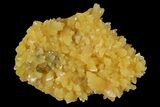This Specimen has been sold.
2.7" Yellow Calcite Crystal Cluster with Barite - South Dakota
This is a cluster of yellow calcite crystals that was collected from Meade County, South Dakota. There is a lustrous yellow-brown barite crystal that formed in association with the calcite. Under long wave and short wave UV, these crystals react by fluorescing orange-yellow (long wave UV) and white-yellow (short wave UV).
About Elk Creek Calcite
Superb rhombohedral crystals of septarian calcite occur in cavities within large concretions from the 70-million-year-old Pierre Shale in Elk Creek, South Dakota. The calcite crystals can be yellow, orange, or gold in color and are sometimes associated with golden barite crystals and selenite. The calcite crystals fluoresce a bright yellow-white under shortwave UV light.
Superb rhombohedral crystals of septarian calcite occur in cavities within large concretions from the 70-million-year-old Pierre Shale in Elk Creek, South Dakota. The calcite crystals can be yellow, orange, or gold in color and are sometimes associated with golden barite crystals and selenite. The calcite crystals fluoresce a bright yellow-white under shortwave UV light.
About Calcite Crystals
Calcite crystals are a form of calcium carbonate (CaCO₃) known for their diverse shapes, transparency, and vibrant range of colors. They typically form in rhombohedral, scalenohedral, or prismatic shapes, often with well-defined, sharp edges and glossy surfaces. Calcite crystals are often translucent or transparent, sometimes displaying a double refraction effect where objects viewed through the crystal appear doubled. They can appear in various colors—white, clear, yellow, pink, blue, green, and orange—depending on impurities or trace minerals.
A notable characteristic of calcite is its reaction with weak acids like vinegar, which causes it to effervesce, or fizz, as it releases carbon dioxide. This property makes calcite crystals a key tool in geological identification and studies. Calcite forms in many environments, from sedimentary rocks like limestone and marble to hydrothermal veins.
Calcite crystals are a form of calcium carbonate (CaCO₃) known for their diverse shapes, transparency, and vibrant range of colors. They typically form in rhombohedral, scalenohedral, or prismatic shapes, often with well-defined, sharp edges and glossy surfaces. Calcite crystals are often translucent or transparent, sometimes displaying a double refraction effect where objects viewed through the crystal appear doubled. They can appear in various colors—white, clear, yellow, pink, blue, green, and orange—depending on impurities or trace minerals.
A notable characteristic of calcite is its reaction with weak acids like vinegar, which causes it to effervesce, or fizz, as it releases carbon dioxide. This property makes calcite crystals a key tool in geological identification and studies. Calcite forms in many environments, from sedimentary rocks like limestone and marble to hydrothermal veins.
About Barite (Baryte)
Barite is a barium sulfate mineral (BaSO₄) known for its high specific gravity, which makes it unusually heavy for a non-metallic mineral. Typically forming in tabular or bladed crystals, barite can also appear in massive, fibrous, or nodular habits. Its colors range from colorless and white to shades of blue, yellow, gray, or brown, often influenced by trace impurities. Barite commonly forms in hydrothermal veins, sedimentary rocks, and as a gangue mineral in lead-zinc ore deposits. It is widely used in industrial applications, especially as a weighting agent in drilling muds for oil and gas exploration. Its striking crystal formations and vivid hues also make it a popular mineral for collectors.
Barite is a barium sulfate mineral (BaSO₄) known for its high specific gravity, which makes it unusually heavy for a non-metallic mineral. Typically forming in tabular or bladed crystals, barite can also appear in massive, fibrous, or nodular habits. Its colors range from colorless and white to shades of blue, yellow, gray, or brown, often influenced by trace impurities. Barite commonly forms in hydrothermal veins, sedimentary rocks, and as a gangue mineral in lead-zinc ore deposits. It is widely used in industrial applications, especially as a weighting agent in drilling muds for oil and gas exploration. Its striking crystal formations and vivid hues also make it a popular mineral for collectors.
SPECIES
Calcite & Barite
LOCATION
Elk Creek, Meade County, South Dakota
SIZE
2.7 x 2"
CATEGORY
ITEM
#170678
 Reviews
Reviews














